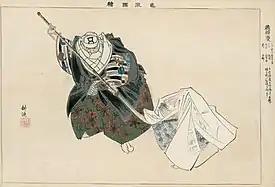
Benkei and Yoshitsune, in disguise, meet on Gojō Bridge, a scene from Hashi Benkei; woodblock print by Kōgyo Tsukioka from the series Nōgaku zue or Pictures of Noh Plays
Benkei on the Bridge (橋弁慶, Hashi Benkei) is a Japanese Noh play from the 15th century, by Hiyoshi Sa-ami Yasukiyo.[1]
Theme
The play centres around the encounter between the giant warrior monk Benkei and the youthful Minamoto no Yoshitsune, in which the slighter, younger man defeated the elder.[2] The hand-to-hand bridge combat forged a lasting bond between the pair.[3]
Thereafter Benkei served as Yoshitsune’s second in command[4] - as what Basho would describe as “his faithful retainer, Benkei”.[5]
Later developments
Buson created a haiku and a haiku painting, Benkei and Young Bull, around the themes of the play, quoting from it in his haiku:
“Snow, moon, and blossoms -
And then a pledge for three lives,
Faith and loyalty”.[6]
See also
Wikimedia Commons has media related to Hashi Benkei.
References
- ↑ A Waley, The Noh Plays of Japan (1976) p. 52
- ↑ L Zolbrod, Haiku Painting (Tokyo 1982) p. 12
- ↑ L Zolbrod, Haiku Painting (Tokyo 1982) p. 12
- ↑ H McAlpine, Japanese Tales and Legends (London 1960) p. 56
- ↑ Basho, The Narrow Road to the Deep North (Penguin 1983) p. 109
- ↑ L Zolbrod, Haiku Painting (Tokyo 1982) p. 12-13
External links
This article is issued from Wikipedia. The text is licensed under Creative Commons - Attribution - Sharealike. Additional terms may apply for the media files.